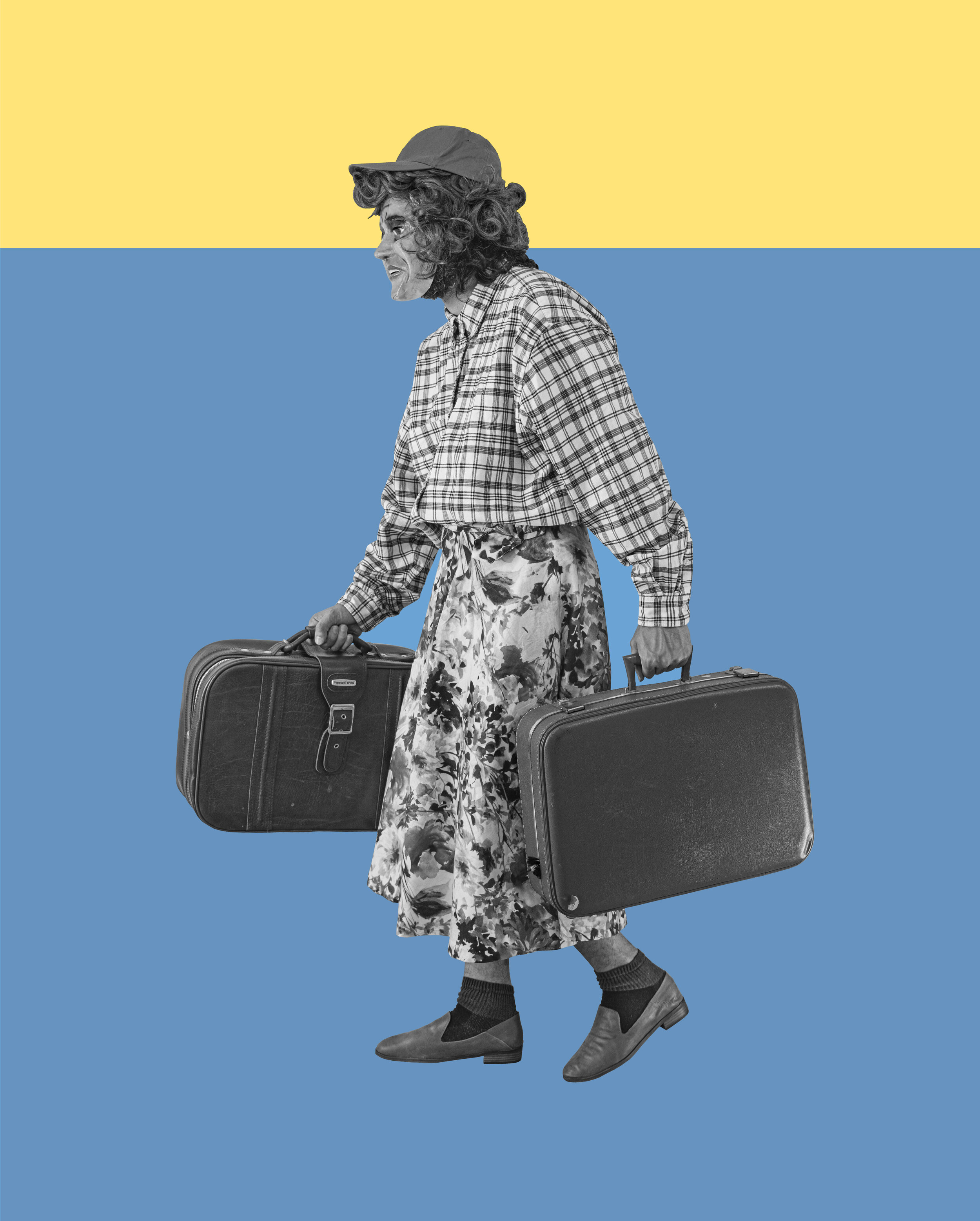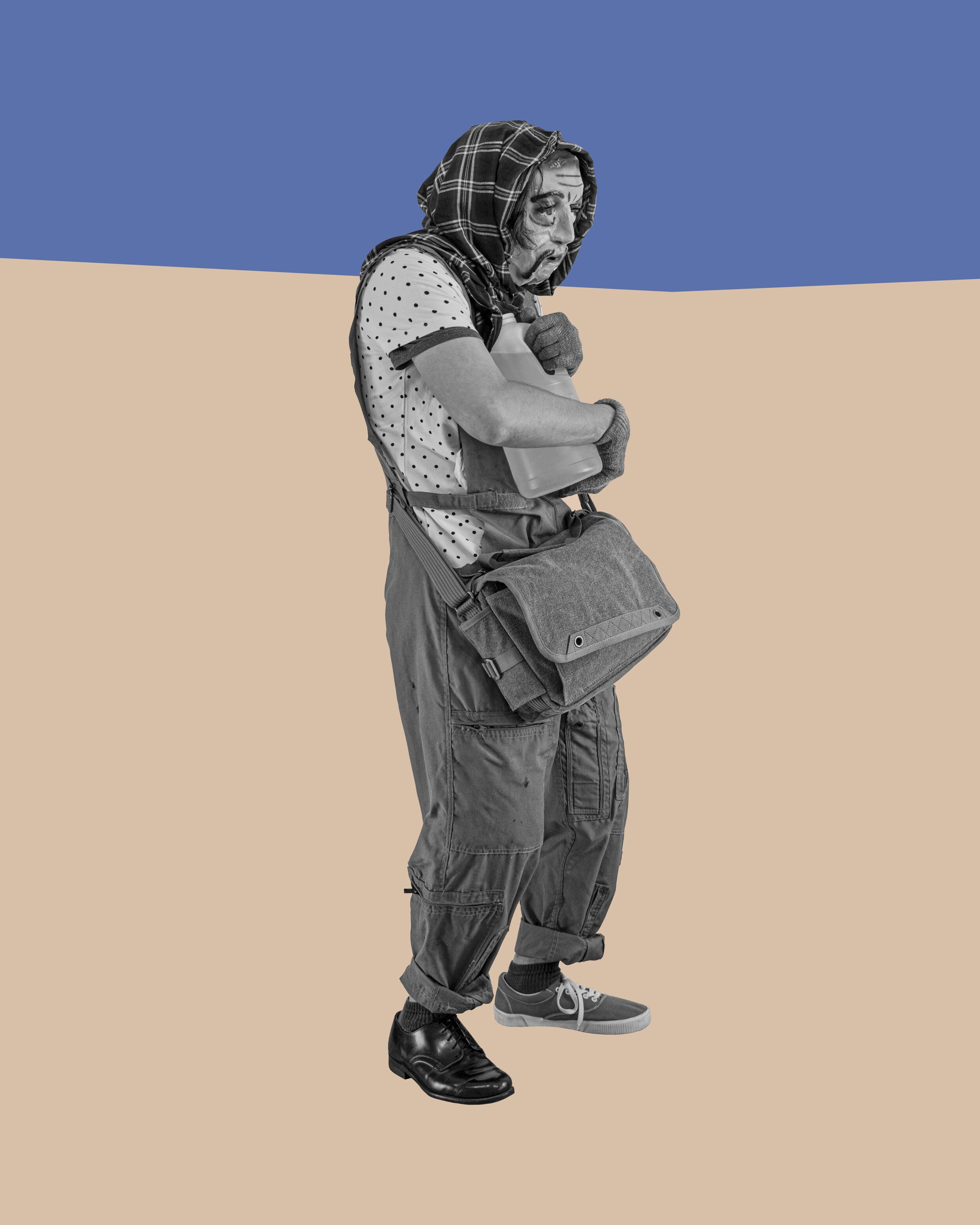LAND ESCAPE PAINTINGS
Acrylic house paint on canvas, print on archival cotton paper, barbed wire, galvanized poles, concrete.
9 x 7.2 feet / 274 x 219.5 cm
2020










NO ESCAPE: EDISON PEÑAFIEL’S LAND ESCAPE PAINTINGS
The future is already here, it just isn’t evenly distributed.
—William Gibson
We stomp dangerously, Bertrand Russell wrote in praise of Joseph Conrad’s skewering of Western exceptionalism in the novels Heart of Darkness and Lord Jim, “on a thin crust of barely cooked lava which at any moment might break and let the unwary sink into its fiery depths.” Russell’s words—written more than a half century ago—echo furiously from the past while pointing an accusing finger at a much larger civilizational threat: the link between climate change and mass migration. Both are the subjects of American artist Edison Peñafiel’s latest installation. His fitting title for his ten colorful XL paintings of climate refugees penned in by barbed wire fencing arrayed around the walls of Piero Atchugarry Gallery: Land Escape.
To paraphrase David Wallace-Wells’s 2019 barnburner, The Uninhabitable Earth, the vast majority of the citizen-consumers inhabiting Western countries think of refugees as a failed state problem—that is, as socioeconomic fallout the global South inflicts on the global North. But that view has been proven to be fake news by climate science and devastating new planetary weather patterns. In 2017, Hurricane Harvey produced at least 60,000 climate migrants in Texas and Hurricane Irma forced the evacuation of nearly 7 million people. By 2100, Wallace-Wells writes, “sea-level rise alone could displace 21 million Americans,” with many refugees coming “from the country’s southeast—chiefly Florida,” where 2.5 million are expected to be flooded out of the greater Miami area. Far from being a local problem for the governments of Guatemala, Venezuela, The Bahamas, or Cuba, the human cost of climate change has come due for the residents of Miami-Dade, Broward, Hillsborough, Palm Beach, and Pinellas counties.
Rendered as canvas-backed photographic images of first-world Americans (or Britons, Germans, Spaniards, Australians, et al) having metamorphosed into the Other, the exposure of the world’s consumer class to the miseries and deprivations of the planet’s survivalist masses—generational poverty, epochal flooding, economic stagnation, pandemics, political instability, mass migration—becomes the driving metaphor behind Peñafiel’s monumentally solitary subjects. Pictured in black and white to recall, among other everyman antecedents, Charlie Chaplin’s Little Tramp, and against loudly chromatic backgrounds to broadly suggest both actual landscapes and street art, these paintings portray masked figures engaged in a timeless yet desperately urgent modern pursuit: fleeing disaster into unknown exile.
If, like Cindy Sherman, Peñafiel has chosen to employ the uncanny effects of self-portraiture to inhabit each of the ten character studies he presents, he has done so chiefly to dramatize an ongoing mass evacuation of human beings that is projected to dwarf the 20th century’s Great Migration, the movement of 6 million African-Americans across the North American continent dramatized by artist Jacob Lawrence in his 60-panel masterpiece The Migration Series (1940-41). Where Sherman uses an arsenal of wigs, costumes, makeup, and props for her various imagined characters, Peñafiel’s stripped-down impostures sport non-descript clothing (the better to avoid specific references) and traditional Latin American festive masks (which connect to both ideas of anonymity as well as ritual scapegoating). The fact that Peñafiel’s painting’s are hung on facing walls and point in a single direction—toward the gallery’s glowing “Exit” sign—recalls the last panel of Lawrence’s celebrated series. Its caption reads simply: “And the migrants kept coming.”
Large-scale compositions that make non-hierarchical use of the disciplines of painting, photography, collage, and installation art, Peñafiel’s photo-based canvases extend the polymath artist’s efforts to relay one of this century’s most urgent narratives across multiple media. Inspired in no small part by the artist’s own experience as an immigrant to the U.S. from Ecuador, his canvases simultaneously materialize and monumentalize forms, compositions, and scenarios he first displayed as large-scale video and photo installations in three separate instances in 2019. These were in Corsicana, Texas’ celebrated 100W residency; at the Museum of Contemporary Art, North Miami; and in a street-level installation on Collins Avenue in Miami Beach organized by the Bass Museum of Art. Epic views of an evolving human tragedy of trans-historical proportions, Peñafiel’s faceless cast of global down-and-out characters also serves as a chronicle of a profoundly personal story of precarious displacement, forced travel, and epochal insecurity.
In the words of mathematician Eli Khamarov: “Poverty is like punishment for a crime you didn't commit.” That goes triple for an age that has so exacerbated global indigence that its natural byproducts—social, political, and economic insecurity, currently multiplied by climate instability and wealth disparity—have rapidly intensified what The New York Times recently termed, in a series of in-depth stories, “The Great Climate Migration.” For these articles, journalists Abraham Lustgarten and Meridith Kohut profiled an anonymous Guatemalan farming family devastated by the worsening weather pattern equivocally known as El Niño; predictably, drought, flood and bankruptcy forced them to liquidate their belongings and flee north. Peñafiel’s canvases reflect their story, as well as that of millions of other families—from Sub-Saharan Africa to Southeast Asia to Central America—who have fallen prey to “life after warming,” but with an important caveat. Absent certain key distinguishing geographical, ethnic, national and socioeconomic backstories, the figures animating the artist’s paintings are meant to stand in for us—The Walking Dead-inspired, post-apocalyptic version. Not for nothing do Peñafiel’s raffishly costumed players carry vintage luggage and resemble stock characters out of the plays of Samuel Beckett.
Boiled down to their essential expression, Peñafiel’s canvases, like Lawrence’s panels (the African-American artist called his style “dynamic cubism”), also invoke certain generic characteristics associated with conventional landscape paintings while, alternately, frustrating others. Peñafiel’s canvases, for instance, sport an anthropomorphized orientation; that is to say, they are constructed vertically rather than horizontally with a view to underscoring the human drama of their calamitous narratives. Secondly, the artist uses geometric blocks of color to schematically describe the deracinated vistas he names in his paintings’ titles. Cerro (hill), for example, denotes a dun-colored diagonal area of flat paint with a sky-blue background; Pampa (prairie) two parallel zones of color laid horizontally one atop the other; Desierto (desert) an uninterrupted and uniform application of yellow paint; while Abyss denotes a cramped arrangement of blocks of dark color that literally crowd a dejected figure inside a tiny space. It’s not a stretch to say that that space resembles a cell.
Like Lawrence, Peñafiel is bent on arriving at a demotic set of forms that channel the tragedy that is mass migration during the Anthropocene, the geological epoch dominated by homo sapiens. For this purpose, he has distilled what amounts to one of the biggest events in recorded history into a set of recurring figures, vignettes, colors and geometric shapes. According to the ecotheorist Timothy Morton, part of what makes the idea of climate change and its associated effects, such as the displacement of millions of human beings around the globe, so difficult to comprehend is its sheer vastness—its facts are so overwhelming and complex that they can hardly be fully comprehended by historians, economists, geographers, demographers, anthropologists, and climate scientists.
What Peñafiel does in his Land Escape canvases is condense, concentrate and symbolically recast these imagination-defying events into paint and contemporary images. For the figures populating the artist’s Land Escape paintings there is no escape. For the rest of us, Peñafiel’s artworks constitute a rough portrait of the lifestyle class running for their lives—it should serve as a dire warning or even a call to action.
Christian Viveros-Fauné
Brooklyn, 2020
EXHIBITIONS
LAND ESCAPE PAINTINGS
Piero Atchugarry Gallery, Miami - FL
September 16 - November 14, 2020






BUM BUM BA YE [ UNDER PRESSURE ]
Sabrina Amrani Gallery, Madrid - Spain
April 20 - May 29, 2021



Bum bum ba ye [Under pressure], a group show that invites us to reflect on the different tensions that shape our world, showcasing works by Manal AlDowayan, Amina Benbouchta, Gabriela Bettini, Zoulikha Bouabdellah, Babak Golkar, Ayesha Jatoi, Timothy Hyunsoo Lee, Mónica de Miranda, Edison Peñafiel, Dagoberto Rodríguez and Jorge Tacla.
The exhibition borrows the title of the famous song by Queen and David Bowie, released in 1981, a peak year in terms of political and social events in the world. Bowie's lyrics allude to the oppression and stress subjected to individuals, and therefore to the external factors that cause them. From different geographies and contexts, the works gathered in this exhibition address the tensions and vital aspects of a society in decline, both on the social and political level, as well as on the natural level.
Globalization, in its beginnings, proposed the hypothesis of a certain homogenization of the inequalities established in markets and economies of the world. Carried by the development of information technologies and the media, globalization spread in the popular imagination before it could fulfill this hypothesis, underlining in the eyes of all the dissonance between the realities of one and the other. The finding, decades later, is the ambivalence of this initial hypothesis: by creating mass consumption, globalization has increased the exploitation of natural resources; motivating the displacement of individuals while setting up systems to control the migratory process, or favoring cultural exchange but fragmenting identities.
The works in the exhibition affect only some of the problems of today's society, often personal experiences of the artists. They invite us to review the Histories, from the first botanical expeditions to Latin America, the Second World War, the revolution in Angola, and the Chilean coup, to current immigration and industrialization policies or terrorism and modern warfare. Different realities that exemplify different class societies1, structures of violence, oppression and exploitation that have existed and continue to exist in our world. The exhibition aims to show the interdependence of everything with everything. An intersocial world2, «where relations between societies govern world affairs, where all men are linked, the weak and the strong. The sufferings of others become mechanically ours. This intersociality runs faster than decision. It produces its effect even before politics has taken over.»3
Bum bum ba ye [Under pressure], like the song, is a wish, a holistic hope for a better society, more equitable systems, and a greater understanding of the other.
Photo: Sabrina Amrani Gallery
ARCOMadrid
Sabrina Amrani Gallery, Madrid - Spain
July 7 - 11, 2021

A group presentation of works by :mentalKLINIK, Joël Andrianomearisoa, Gabriela Bettini, Babak Golkar, Alexandra Karakashian, Timothy Hyunso Lee, Julia Llerena, Mónica de Miranda, Edison Peñafiel, Paloma Polo, Dagoberto Rodríguez and Jorge Tacla.